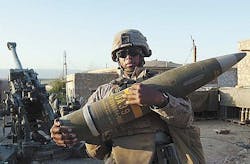Raytheon to provide 216 satellite-guided heavy artillery shells to attack moving targets
Raytheon Missile Systems won a $15.1 million contract modification this week to provide M982 Excalibur smart munitions. Awarding the contract were officials of the Army Contracting Command at Picatinny Arsenal, N.J.
Related: GPS-guided 155-millimeter artillery rounds provided to U.S. Army by Raytheon
The M982 Excalibur precision-guided, extended-range artillery shell is a fire-and-forget smart munition with better accuracy than existing 155-millimeter artillery rounds. These shells are fin-stabilized, and are designed to glide to targets with base bleed technology, as well as with canards located at the front of the munition that create aerodynamic lift.
Although the M982 is perhaps the longest-range artillery ammunition in the U.S. arsenal, it has the ability to be fired nearly straight up from positions in cities or hilly terrain and engage its precision-guidance system at high altitudes, and detect and attack moving targets -- even individual vehicles -- with an accuracy of better than 65 feet from the desired aim point.
The shells are guided by global positioning system (GPS) satellite navigation and inertial measurement unit, and can be fired from the M109A6 Paladin self-propelled howitzer, as well as from the M198 and M777A2 towed howitzers.
Related: BAE Systems adds to contract for upgrading Paladin artillery with new engine and vetronics
Excalibur artillery shells come in three kinds: high-explosive; smart munitions that detect and attack moving targets; and shells able to identify and attack vehicles individually in cities and other complicated terrain.
Excalibur first was fielded in Iraq in 2007 for urban or complex-terrain engagements in which collateral damage must be kept to a minimum. The munition is designed to be fired at a high-angle and change its flight path to hit its target.
Related: One shot: smart munitions put weapons on target
Raytheon will do the work in Tucson, Ariz.; McAlester, Okla.; Farmington, N.M.; East Camden, Ark.; Healdsburg, Calif.; Anniston, Ala.; Cincinnati; Cedar Rapids, Iowa; Joplin, Mo.; Lowell, Mass.; Corona, Calif.; Inglewood, Calif.; Chino, Calif.; Minneapolis; Santa Ana, Calif.; McKinney, Texas; Phoenix; Woodridge, Ill.; Valencia, Calif.; Salt Lake City; Congers, N.Y.; as well as in the United Kingdom and Sweden. Work should be finished in early 2015.
For more information contact Raytheon Missiles Systems online at www.raytheon.com/ourcompany/businesses, or the Army Contracting Command at Picatinny Arsenal at http://procnet.pica.army.mil.
